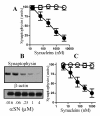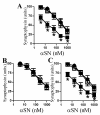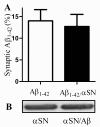α-synuclein induced synapse damage is enhanced by amyloid-β1-42
- PMID: 21138585
- PMCID: PMC3017026
- DOI: 10.1186/1750-1326-5-55
α-synuclein induced synapse damage is enhanced by amyloid-β1-42
Abstract
Background: The pathogenesis of Parkinson's disease (PD) and dementia with Lewy bodies (DLB) is associated with the accumulation of aggregated forms of the α-synuclein (αSN) protein. An early event in the neuropathology of PD and DLB is the loss of synapses and a corresponding reduction in the level of synaptic proteins. However, the molecular mechanisms involved in synapse damage in these diseases are poorly understood. In this study the process of synapse damage was investigated by measuring the amount of synaptophysin, a pre-synaptic membrane protein essential for neurotransmission, in cultured neurons incubated with αSN, or with amyloid-β (Aβ) peptides that are thought to trigger synapse degeneration in Alzheimer's disease.
Results: We report that the addition of recombinant human αSN reduced the amount of synaptophysin in cultured cortical and hippocampal neurons indicative of synapse damage. αSN also reduced synaptic vesicle recycling, as measured by the uptake of the fluorescent dye FM1-43. These effects of αSN on synapses were modified by interactions with other proteins. Thus, the addition of βSN reduced the effects of αSN on synapses. In contrast, the addition of amyloid-β (Aβ)1-42 exacerbated the effects of αSN on synaptic vesicle recycling and synapse damage. Similarly, the addition of αSN increased synapse damage induced by Aβ1-42. However, this effect of αSN was selective as it did not affect synapse damage induced by the prion-derived peptide PrP82-146.
Conclusions: These results are consistent with the hypothesis that oligomers of αSN trigger synapse damage in the brains of Parkinson's disease patients. Moreover, they suggest that the effect of αSN on synapses may be influenced by interactions with other peptides produced within the brain.
Figures







References
-
- Cabin DE, Shimazu K, Murphy D, Cole NB, Gottschalk W, McIlwain KL, Orrison B, Chen A, Ellis CE, Paylor R. et al.Synaptic vesicle depletion correlates with attenuated synaptic responses to prolonged repetitive stimulation in mice lacking alpha-synuclein. J Neurosci. 2002;22(20):8797–8807. - PMC - PubMed
Grants and funding
LinkOut - more resources
Full Text Sources

